Urban Academy
Download as pptx, pdf0 likes412 views
Presentation at Helsinki Challenge PitchNight 3.9.2015
1 of 6
Download to read offline
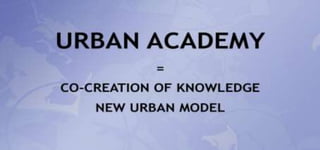
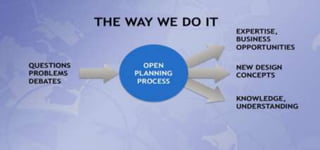
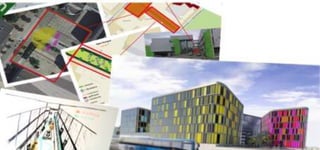
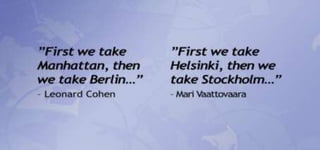
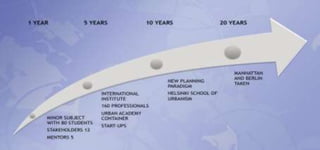
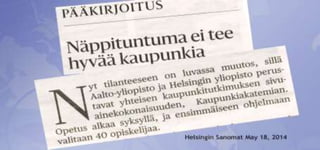
Ad
Recommended
Viewfinder
ViewfinderHelsinki Challenge by the University of Helsinki
╠²
The document introduces Viewfinder, a new dialogue method and crowdsourced platform to facilitate interdisciplinary work between scientists and help the public better understand science. It provides contact information for the founders and outlines their goals of initially engaging scientists, then policy makers, and ultimately the broader public to help address the challenge that science can feel fragmented and difficult to understand for non-experts.The Happiness Project
The Happiness ProjectHelsinki Challenge by the University of Helsinki
╠²
Presentation at Helsinki Challenge PitchNight 3.9.2015 Helsinki sleep factory
Helsinki sleep factoryHelsinki Challenge by the University of Helsinki
╠²
Presentation at Helsinki Challenge PitchNight 3.9.2015 Higher education unbounded
Higher education unboundedHelsinki Challenge by the University of Helsinki
╠²
Presentation at Helsinki Challenge PitchNight 3.9.2015 The Citizens Mindscapes
The Citizens MindscapesHelsinki Challenge by the University of Helsinki
╠²
Presentation at Helsinki Challenge PitchNight 3.9.2015 Tell Us
Tell UsHelsinki Challenge by the University of Helsinki
╠²
Presentation at Helsinki Challenge PitchNight 3.9.2015 Sustainability Tracker
Sustainability TrackerHelsinki Challenge by the University of Helsinki
╠²
Presentation at Helsinki Challenge PitchNight 3.9.2015 Safepreg
SafepregHelsinki Challenge by the University of Helsinki
╠²
Presentation at Helsinki Challenge PitchNight 3.9.2015 Play Learn Heal
Play Learn HealHelsinki Challenge by the University of Helsinki
╠²
Presentation at Helsinki Challenge PitchNight 3.9.2015 Natural Emotionality in Digital Interaction
Natural Emotionality in Digital InteractionHelsinki Challenge by the University of Helsinki
╠²
Presentation at Helsinki Challenge PitchNight 3.9.2015 Moralities of Intelligent Machines
Moralities of Intelligent MachinesHelsinki Challenge by the University of Helsinki
╠²
Presentation at Helsinki Challenge PitchNight 3.9.2015 Lab Impact Africa
Lab Impact AfricaHelsinki Challenge by the University of Helsinki
╠²
Presentation at Helsinki Challenge PitchNight 3.9.2015 Ground&growth
Ground&growthHelsinki Challenge by the University of Helsinki
╠²
Presentation at Helsinki Challenge PitchNight 3.9.2015 Genetic correction
Genetic correctionHelsinki Challenge by the University of Helsinki
╠²
Over 300 million families worldwide are affected by inherited hemoglobin diseases but CRISPR gene editing offers a potential cure. The document outlines a treatment strategy using CRISPR to modify the hemoglobin gene in patients, allowing production of functional fetal hemoglobin and a cure. This approach has shown promise in genetically modifying cells to increase fetal hemoglobin levels by 100%, and the goal is to benefit millions through clinical trials and an approved therapy by 2035.Generation green
Generation greenHelsinki Challenge by the University of Helsinki
╠²
Jenny McDowell from Monash University in Australia wants to include sustainability education in their course offerings going forward. She stated "I AM KEEN TO INCORPORATE SUSTAINABILITY EDUCATION IN OUR COURSES AS WE GO FORWARD." McDowell is looking to add sustainability topics to the university's curriculum.Futurorg
FuturorgHelsinki Challenge by the University of Helsinki
╠²
Presentation at Helsinki Challenge PitchNight 3.9.2015 Engaging working environments
Engaging working environmentsHelsinki Challenge by the University of Helsinki
╠²
Presentation at Helsinki Challenge PitchNight 3.9.2015 Climate whirl
Climate whirlHelsinki Challenge by the University of Helsinki
╠²
Presentation at Helsinki Challenge PitchNight 3.9.2015 Biodiversity now
Biodiversity nowHelsinki Challenge by the University of Helsinki
╠²
Presentation at Helsinki Challenge PitchNight 3.9.2015Ulrich Weinberg: Impact Camp Presentation on Design Thinking.
Ulrich Weinberg: Impact Camp Presentation on Design Thinking. Helsinki Challenge by the University of Helsinki
╠²
The document outlines the Hasso Plattner Institute's School of Design Thinking, highlighting its founding, focus on innovation, and diverse student body comprising 120 students across 20 nationalities. It details the course structure, principles of design thinking, and examples of student projects aimed at addressing social challenges. Additionally, it mentions professional tracks for corporate training and collaborations in various fields such as health and logistics.Anatomy of Impact by Demos Helsinki
Anatomy of Impact by Demos HelsinkiHelsinki Challenge by the University of Helsinki
╠²
The document discusses the importance of impact in health and social programs, specifically focusing on the history of maternity and child care clinics in Finland and their success in reducing maternal and infant mortality rates. It highlights the role of health sisters and midwives in providing essential prenatal care, achieving near-total coverage of pregnant women by 2015. Additionally, it mentions the development of a new population projection model informed by ongoing research and collaboration with policymakers in various Asian regions.The Happiness Project
The Happiness ProjectHelsinki Challenge by the University of Helsinki
╠²
The document discusses happiness and how it relates to interaction with others. It argues that happiness is found through interaction rather than by pursuing it alone or viewing it as a possession. The challenge is developing linguistic awareness and concrete tools to change behavior and spread ideas about finding happiness in interaction. The project aims to participate in schools, workplaces and media to provide solutions.Demos helsinki Anatomy of Impact - What we do?
Demos helsinki Anatomy of Impact - What we do?Helsinki Challenge by the University of Helsinki
╠²
This document outlines the process and activities for a challenge to develop solutions that create impact. It involves defining problems, ideating concepts, testing feasibility, and delivering solutions through converging and diverging phases. Participants are guided to define target users, partners, and scope of impact. The process focuses on understanding needs, benefits, resources, and touchpoints through user research. It aims to develop solutions in collaboration with partners and users to maximize real-world impact.Generation Green
Generation GreenHelsinki Challenge by the University of Helsinki
╠²
The document discusses the need for reforming curricula to create a "Generation Green" with a strong environmental focus. It notes that the global population is projected to reach 9 billion by 2050, putting increasing pressure on limited resources like clean drinking water, which over 1.8 billion people currently lack access to. Individual actions alone will not lead to sustainable solutions, so curricula are needed to facilitate a comprehensive understanding of environmental resource management and ensure clean resources for all through scalable, sustainable practices. The document calls readers to join this effort to educate the next "Generation Green" and help address worldwide resource challenges.Helsinki Sleep Factory
Helsinki Sleep FactoryHelsinki Challenge by the University of Helsinki
╠²
The Helsinki Sleep Factory is a virtual sleep society that aims to help adolescents understand and improve their sleep through a combination of chronobiology, motivational psychology, medicine, and problem-based learning approaches. It provides personalized sleep resources and solutions through an intelligent sleep diary, relaxation and mindfulness exercises, and a social community for sharing sleep-related content. The goal is to create accessible and effective interventions for conditions like delayed sleep phase, which can cause learning problems and school absenteeism if not addressed.Biodiversity Now!
Biodiversity Now!Helsinki Challenge by the University of Helsinki
╠²
Biodiversity is being destroyed through many small incremental changes over time. This loss threatens our well-being and ability to adapt to climate change. To address this, the document proposes developing new mechanisms to neutralize negative impacts on biodiversity and turn losses into gains, such as through biodiversity offsets. Offsets involve compensating for biodiversity loss in one area by improving biodiversity elsewhere. This could create a market-based solution and new business opportunities, implementing the "polluter pays" principle. The proposal aims to incorporate offsets into legislation to balance development with conserving biodiversity in Finland.Ground and Growth
Ground and GrowthHelsinki Challenge by the University of Helsinki
╠²
Presentation at Helsinki Challenge Pitch Night Jan 29, 2015.Citizen Mindscapes
Citizen MindscapesHelsinki Challenge by the University of Helsinki
╠²
This document proposes creating a "Citizen Mindscapes" project to analyze social media data from Suomi24 discussions in order to:
1) Detect early signs of social conflicts and problems in Finland;
2) Work against national divisions and support diversity; and
3) Strengthen skills in social big data analysis for research and business.
The project would involve analyzing the tens of millions of texts on Suomi24, which is used by 80% of Finns, to understand sentiments, consumption styles, hate speech, behaviors, and rhythms of everyday life and the economy.overview visual graphic design for SHS.pptx
overview visual graphic design for SHS.pptxKarlVincentNonog
╠²
visual graphic design requirements, competency and house rules of vcd nc iiiMore Related Content
More from Helsinki Challenge by the University of Helsinki (20)
Play Learn Heal
Play Learn HealHelsinki Challenge by the University of Helsinki
╠²
Presentation at Helsinki Challenge PitchNight 3.9.2015 Natural Emotionality in Digital Interaction
Natural Emotionality in Digital InteractionHelsinki Challenge by the University of Helsinki
╠²
Presentation at Helsinki Challenge PitchNight 3.9.2015 Moralities of Intelligent Machines
Moralities of Intelligent MachinesHelsinki Challenge by the University of Helsinki
╠²
Presentation at Helsinki Challenge PitchNight 3.9.2015 Lab Impact Africa
Lab Impact AfricaHelsinki Challenge by the University of Helsinki
╠²
Presentation at Helsinki Challenge PitchNight 3.9.2015 Ground&growth
Ground&growthHelsinki Challenge by the University of Helsinki
╠²
Presentation at Helsinki Challenge PitchNight 3.9.2015 Genetic correction
Genetic correctionHelsinki Challenge by the University of Helsinki
╠²
Over 300 million families worldwide are affected by inherited hemoglobin diseases but CRISPR gene editing offers a potential cure. The document outlines a treatment strategy using CRISPR to modify the hemoglobin gene in patients, allowing production of functional fetal hemoglobin and a cure. This approach has shown promise in genetically modifying cells to increase fetal hemoglobin levels by 100%, and the goal is to benefit millions through clinical trials and an approved therapy by 2035.Generation green
Generation greenHelsinki Challenge by the University of Helsinki
╠²
Jenny McDowell from Monash University in Australia wants to include sustainability education in their course offerings going forward. She stated "I AM KEEN TO INCORPORATE SUSTAINABILITY EDUCATION IN OUR COURSES AS WE GO FORWARD." McDowell is looking to add sustainability topics to the university's curriculum.Futurorg
FuturorgHelsinki Challenge by the University of Helsinki
╠²
Presentation at Helsinki Challenge PitchNight 3.9.2015 Engaging working environments
Engaging working environmentsHelsinki Challenge by the University of Helsinki
╠²
Presentation at Helsinki Challenge PitchNight 3.9.2015 Climate whirl
Climate whirlHelsinki Challenge by the University of Helsinki
╠²
Presentation at Helsinki Challenge PitchNight 3.9.2015 Biodiversity now
Biodiversity nowHelsinki Challenge by the University of Helsinki
╠²
Presentation at Helsinki Challenge PitchNight 3.9.2015Ulrich Weinberg: Impact Camp Presentation on Design Thinking.
Ulrich Weinberg: Impact Camp Presentation on Design Thinking. Helsinki Challenge by the University of Helsinki
╠²
The document outlines the Hasso Plattner Institute's School of Design Thinking, highlighting its founding, focus on innovation, and diverse student body comprising 120 students across 20 nationalities. It details the course structure, principles of design thinking, and examples of student projects aimed at addressing social challenges. Additionally, it mentions professional tracks for corporate training and collaborations in various fields such as health and logistics.Anatomy of Impact by Demos Helsinki
Anatomy of Impact by Demos HelsinkiHelsinki Challenge by the University of Helsinki
╠²
The document discusses the importance of impact in health and social programs, specifically focusing on the history of maternity and child care clinics in Finland and their success in reducing maternal and infant mortality rates. It highlights the role of health sisters and midwives in providing essential prenatal care, achieving near-total coverage of pregnant women by 2015. Additionally, it mentions the development of a new population projection model informed by ongoing research and collaboration with policymakers in various Asian regions.The Happiness Project
The Happiness ProjectHelsinki Challenge by the University of Helsinki
╠²
The document discusses happiness and how it relates to interaction with others. It argues that happiness is found through interaction rather than by pursuing it alone or viewing it as a possession. The challenge is developing linguistic awareness and concrete tools to change behavior and spread ideas about finding happiness in interaction. The project aims to participate in schools, workplaces and media to provide solutions.Demos helsinki Anatomy of Impact - What we do?
Demos helsinki Anatomy of Impact - What we do?Helsinki Challenge by the University of Helsinki
╠²
This document outlines the process and activities for a challenge to develop solutions that create impact. It involves defining problems, ideating concepts, testing feasibility, and delivering solutions through converging and diverging phases. Participants are guided to define target users, partners, and scope of impact. The process focuses on understanding needs, benefits, resources, and touchpoints through user research. It aims to develop solutions in collaboration with partners and users to maximize real-world impact.Generation Green
Generation GreenHelsinki Challenge by the University of Helsinki
╠²
The document discusses the need for reforming curricula to create a "Generation Green" with a strong environmental focus. It notes that the global population is projected to reach 9 billion by 2050, putting increasing pressure on limited resources like clean drinking water, which over 1.8 billion people currently lack access to. Individual actions alone will not lead to sustainable solutions, so curricula are needed to facilitate a comprehensive understanding of environmental resource management and ensure clean resources for all through scalable, sustainable practices. The document calls readers to join this effort to educate the next "Generation Green" and help address worldwide resource challenges.Helsinki Sleep Factory
Helsinki Sleep FactoryHelsinki Challenge by the University of Helsinki
╠²
The Helsinki Sleep Factory is a virtual sleep society that aims to help adolescents understand and improve their sleep through a combination of chronobiology, motivational psychology, medicine, and problem-based learning approaches. It provides personalized sleep resources and solutions through an intelligent sleep diary, relaxation and mindfulness exercises, and a social community for sharing sleep-related content. The goal is to create accessible and effective interventions for conditions like delayed sleep phase, which can cause learning problems and school absenteeism if not addressed.Biodiversity Now!
Biodiversity Now!Helsinki Challenge by the University of Helsinki
╠²
Biodiversity is being destroyed through many small incremental changes over time. This loss threatens our well-being and ability to adapt to climate change. To address this, the document proposes developing new mechanisms to neutralize negative impacts on biodiversity and turn losses into gains, such as through biodiversity offsets. Offsets involve compensating for biodiversity loss in one area by improving biodiversity elsewhere. This could create a market-based solution and new business opportunities, implementing the "polluter pays" principle. The proposal aims to incorporate offsets into legislation to balance development with conserving biodiversity in Finland.Ground and Growth
Ground and GrowthHelsinki Challenge by the University of Helsinki
╠²
Presentation at Helsinki Challenge Pitch Night Jan 29, 2015.Citizen Mindscapes
Citizen MindscapesHelsinki Challenge by the University of Helsinki
╠²
This document proposes creating a "Citizen Mindscapes" project to analyze social media data from Suomi24 discussions in order to:
1) Detect early signs of social conflicts and problems in Finland;
2) Work against national divisions and support diversity; and
3) Strengthen skills in social big data analysis for research and business.
The project would involve analyzing the tens of millions of texts on Suomi24, which is used by 80% of Finns, to understand sentiments, consumption styles, hate speech, behaviors, and rhythms of everyday life and the economy.Ulrich Weinberg: Impact Camp Presentation on Design Thinking.
Ulrich Weinberg: Impact Camp Presentation on Design Thinking. Helsinki Challenge by the University of Helsinki
╠²
Recently uploaded (20)
overview visual graphic design for SHS.pptx
overview visual graphic design for SHS.pptxKarlVincentNonog
╠²
visual graphic design requirements, competency and house rules of vcd nc iiiCapcut Pro Crack For PC Latest Version {Fully Unlocked}
Capcut Pro Crack For PC Latest Version {Fully Unlocked}Ayesha khan
╠²
COPY & PASTE LINK ¤æē¤æē¤æē
https://pcsoftsfull.org/dl/
CapCut Pro Crack is a popular video editing app for mobile devices! It offers advanced features and capabilities to help you create stunning video.
Guildford Flames Adam Long Helmet Design Challenge 2025
Guildford Flames Adam Long Helmet Design Challenge 2025Tom Hutchinson
╠²
This is my submission for the 2025 Guildford Flames Goaltender Helmet Design Competition for Adam Long. This presentation goes over the different design elements I incorporated into my design of the helmet and justifies what was chosen. It also includes comprehensive views of the helmet from all three side which were to be edited in accordance to the brief.AI-Driven-Personalization-in-UX-Designing-for-One-in-a-Million.pdf
AI-Driven-Personalization-in-UX-Designing-for-One-in-a-Million.pdfSultan Shalakhti
╠²
Why you should attend this event
Talk Title: AI-Driven Personalization in UX: Designing for One in a Million
In this session, Sultan Shalakhti explores how artificial intelligence is reshaping user experience through smart, adaptive personalization. From e-commerce to banking, personalized design has become a key differentiatorŌĆöwhen done right. Learn how to apply AI tools to enhance user journeys, balance personalization with privacy, and build experiences that feel uniquely human. This talk blends strategy, ethics, and real-world use cases for UX professionals ready to embrace the future.
ŌĖ╗
ž╣┘å┘łž¦┘å ž¦┘äž¼┘äž│ž®: ž¦┘䞬ž«žĄ┘ŖžĄ ž¦┘ä┘ģž»ž╣┘ł┘ģ ž©ž¦┘äž░┘āž¦žĪ ž¦┘䞦žĄžĘ┘垦ž╣┘Ŗ ┘ü┘Ŗ ž¬ž¼ž▒ž©ž® ž¦┘ä┘ģž│ž¬ž«ž»┘ģ: ž¬žĄ┘ģ┘Ŗ┘ģ ┘Ŗ┘ä┘Ŗ┘é ž©┘ā┘ä ┘üž▒ž» ž╣┘ä┘ē žŁž»ž®
┘łžĄ┘ü ž¦┘äž¼┘äž│ž®:
┘ŖžŻž«ž░┘垦 ž│┘äžĘž¦┘å ž┤┘äž«ž¬┘Ŗ ┘ü┘Ŗ ┘ćž░┘ć ž¦┘äž¼┘äž│ž® ┘ü┘Ŗ ž¼┘ł┘äž® žŁ┘ł┘ä ┘ā┘Ŗ┘ü ┘Ŗž╣┘Ŗž» ž¦┘äž░┘āž¦žĪ ž¦┘䞦žĄžĘ┘垦ž╣┘Ŗ ž¬ž┤┘ā┘Ŗ┘ä ž¬ž¼ž▒ž©ž® ž¦┘ä┘ģž│ž¬ž«ž»┘ģ ┘ģ┘å ž«┘䞦┘ä ž¦┘䞬ž«žĄ┘ŖžĄ ž¦┘äž░┘ā┘Ŗ ┘łž¦┘ä┘ģ┘Åž¬┘ā┘Ŗ┘æ┘ü. ┘ģ┘å ž¦┘䞬ž¼ž¦ž▒ž® ž¦┘äžź┘ä┘āž¬ž▒┘ł┘å┘Ŗž® žź┘ä┘ē ž¦┘ä┘éžĘž¦ž╣ ž¦┘äž©┘å┘ā┘Ŗžī žŻžĄž©žŁ ž¦┘䞬ž«žĄ┘ŖžĄ ž╣┘åžĄž▒┘ŗž¦ ┘üž¦žĄ┘ä┘ŗž¦ ┘ü┘Ŗ ž¼┘łž»ž® ž¦┘䞬ž¼ž▒ž©ž®ŌĆö┘ł┘ä┘ā┘å ┘ü┘éžĘ ž╣┘åž» ž¬┘å┘ü┘Ŗž░┘ć ž©ž¦┘äž┤┘ā┘ä ž¦┘䞥žŁ┘ŖžŁ. ž│┘垬ž╣ž▒┘ü ž╣┘ä┘ē ┘ā┘Ŗ┘ü┘Ŗž® ž¬┘łžĖ┘Ŗ┘ü žŻž»┘łž¦ž¬ ž¦┘äž░┘āž¦žĪ ž¦┘䞦žĄžĘ┘垦ž╣┘Ŗ ┘䞬žŁž│┘Ŗ┘å ž¦┘äž▒žŁ┘䞦ž¬ ž¦┘äž▒┘é┘ģ┘Ŗž®žī ┘łž¬žŁ┘é┘Ŗ┘é ž¦┘䞬┘łž¦ž▓┘å ž©┘Ŗ┘å ž¦┘䞬ž«žĄ┘ŖžĄ ┘łž¦┘äž«žĄ┘łžĄ┘Ŗž®žī ┘łž©┘垦žĪ ž¬ž¼ž¦ž▒ž© ž▒┘é┘ģ┘Ŗž® ž¬ž©ž»┘ł ž┤ž«žĄ┘Ŗž® ┘łžź┘åž│ž¦┘å┘Ŗž®. ž¼┘äž│ž® ž║┘å┘Ŗž® ž¬ž¼┘ģž╣ ž©┘Ŗ┘å ž¦┘䞦ž│ž¬ž▒ž¦ž¬┘Ŗž¼┘Ŗž®žī ┘łž¦┘䞯ž«┘䞦┘é┘Ŗž¦ž¬žī ┘łž»ž▒ž¦ž│ž¦ž¬ ž¦┘䞣ž¦┘äž® ž¦┘ä┘łž¦┘éž╣┘Ŗž® ┘ä┘ä┘ģžŁž¬ž▒┘ü┘Ŗ┘å ┘ü┘Ŗ ┘ģž¼ž¦┘ä UX.
What you will learn in this session
Understand the Core Concepts of AI-Driven Personalization
Explore UX Design Strategies for Hyper-Personalization
Identify Key Tools and Technologies Behind Personalization
Evaluate the Ethical and Privacy Considerations
Apply Personalization Tactics to Real UX ChallengesAVA-fundamentals-Gavin-Ambrose-Paul-Harris-The-fundamentals-of-typography-AVA...
AVA-fundamentals-Gavin-Ambrose-Paul-Harris-The-fundamentals-of-typography-AVA...FaisalNurWibowo
╠²
Belajar Typegraphy designCanva Pro Crack Free Download 2025 Latest
Canva Pro Crack Free Download 2025 Latestchandchuhdary068
╠²
Copy &Paste Google>>>
https://click4pc.com/after-verification-click-go-to-download-page/
Canva Pro PC Crack is a practical design app to create beautiful montages and compositions with a lot of resources on the platform. Exploratory Experiences Built by Design (UXPA25)
Exploratory Experiences Built by Design (UXPA25)Design for Context
╠²
DiscoveryŌĆ” itŌĆÖs more than just finding a piece of information to complete a specific task. ItŌĆÖs more than just searchŌĆ” it is uncovering the unexpected, the ŌĆ£aha!ŌĆØ moment, or the deeper story behind a familiar subject. It is an experience ŌĆō the user experience ŌĆō within a digital space.
This presentation begins by looking at some design examples within the cultural heritage domain that are crafted to foster and encourage curiosity, leading to discovery. Examples draw on different subjects, particularly ones that blend content from different genres and countries. We will unpack design approaches that deliberately invite curiosity and ŌĆ£horizontal navigationŌĆØ through different information paths. Then, we will look more closely at some techniques that UX designers can use to shape these experiences, such as how to leverage the userŌĆÖs context of use, how to integrate cultural contexts, and how to gracefully find meaning in large scale data sets.Exploring the Diverse Types of Textual Aids
Exploring the Diverse Types of Textual Aidsjenicahmendoza1
╠²
Exploring the Diverse Types of Textual AidsMULTI SENSORY EXPERIENCE DESIGN RESEARCH
MULTI SENSORY EXPERIENCE DESIGN RESEARCHSamuel Thuo
╠²
Excited to share insights from my Dissertation Thesis on Multisensory Experience Design in Art Museums, focusing on Nairobi, Kenya! I have to say that this is the work that set me on my current trajectory and led me to my current design philosophy of design for all senses.
Have you been to a #museum, wanted to touch an exhibit and there you saw an injunction, "Please don't touch"....or "Please speak softly",,,,or "Please no eating in the museum".....or "Please don't use strong perfume".... these injunctions have made museums to be mono-sensory experience oriented, alienating the visitors. These injunctions speak volumes of our innate and inherent desire to want to engage holistically with all our #senses with objects. This is a major problem especially in Kenya's museums, which is a paradox with its rich cultural, and anthropological exhibits that require engagement with all the senses.
Inspired by David Howes' insights from Concordia University, my thesis challenges this status quo by exploring historical precedents. Did you know that in the 18th century, museums encouraged multisensory interaction? Today, there's a global shift towards enhancing museum experiences through multisensory #design, yet Kenya's museums often lag behind international standards.
This research isn't just about aesthetics....it's about fostering meaningful, educational, and socially enriching experiences. By embracing multisensory design, museums can bridge cultural divides and create environments where every visitor feels welcomed and engaged. And want to go back.
Let's spark a conversation about the future of museum experiences. How can we leverage design to make cultural institutions more accessible and inspiring for all? Ad
